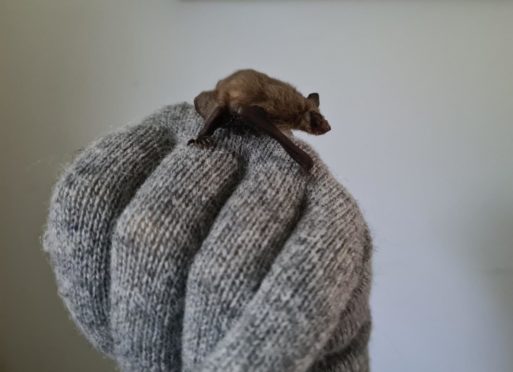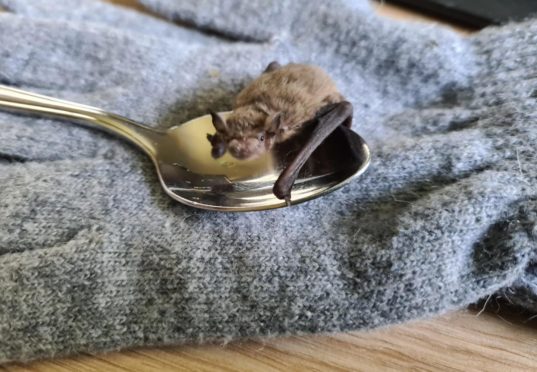A volunteer who rehabilitates bats in Aberdeenshire is fundraising to build a flight cage to give them the “best possible chance”.
Dee Lawlor cares for bats from her home in Ellon, and she has launched a fundraiser to build a flight cage to help rehabilitate them.
Originally from Dublin, Ms Lawlor completed her degree in Zoology in Aberdeen. After volunteering with New Arc she realised she wanted to rehabilitate bats herself.
She said: “Bats are just the cutest things, I’ve always had a soft spot for them and they really are an interesting species.”
The carer is currently looking after three baby bats and explained that this time of year is always busy with the youngsters.
She commented: “It’s just baby bat season. In Scotland it’s a little bit later than in England and Wales because we’re slightly colder up here. So kind of June to July is baby bat season.
“We’ve had so many of them and there’s carers all over Aberdeenshire at the moment looking after them.”
They have a special milk formula, and the carer feeds the littlest ones every four to five hours, including during the night.
For now, Ms Lawlor, who works full-time in science communication, lets her charges stay in her family home, using her bathroom or hallway to give them space to fly.
North-east bat care and rescue
The North East Scotland Bat Group (NESBats) has been running since 2009, and there is a network of members in Aberdeen and around Aberdeenshire.
The group aims to protect and conserve bats, their roosts, feeding areas and hibernation areas in the north-east.
They also promote awareness of bats and bring members together to share skills and knowledge.
The Bat Conservation Trust supports local groups across the UK, such as NESBats and works with over 6,000 members to rehabilitate the mammals.
Ms Lawlor explained: “Bat care and rescue is essentially anyone who finds a bat around their house or their garden or anywhere that’s in distress or needs help you call us and we come and take it, we make it better and put it back into nature.
“Usually what happens is if somebody finds a bat they’ll call the Bat Conservation Trust, they then have a phonebook of carers and they’ll put that person in touch with whoever is closest to them.
“We have a WhatsApp group, so if somebody gets a call and they’re at work or can’t get out at that time, they can contact the group and ask if someone else is available.”
A “conservation crisis”
Scotland is home to nine species of bat, and currently all of them are under threat.
Ms Lawlor believes that rehabilitating bats in the area is important for conservation reasons.
“We’re having a conservation crisis aren’t we?” She said.
“We’re losing so many of our native species, I never thought I’d see a day when hedgehogs were endangered. We’re losing so much habitat, we’re losing all these things, we should be trying our hardest, everybody, to try and protect them.
“Bats have existed for I think it’s like 53 million years and they’ve changed very little in that time, so from an evolutionary point of view that means that from very early on in history they were perfect for the environment that they lived in and they haven’t changed in all that time and then we came along and now we’re making life difficult from them.”
She went on to explain that last year she looked after many adult bats who were underweight, citing starvation as one of the main causes of why bats come into her care.
British bats are obligate insectivores, meaning that they only eat insects. However, in the UK insects are declining because of the use of pesticides.
If the bats do not put on enough weight before hibernation, they will wake up very thin in spring.
Ms Lawlor also explained that loss of habitat is another reason bats are in danger.
How would a flight cage help?
The flight cage is estimated to cost around £3,500 and will be built on Ms Lawlor’s property with a shed attached.
Bats are very small and can fit through gaps in door frames, so the shed would act as an “airlock entrance”.
It would also be used for storing equipment or as a workspace for anyone who needed it.
She has a GoFundMe set up and is fundraising through her Facebook page The Bat Bothy, with the aim to make it a facility for bat carers in the area to use.
Wildlife volunteers pay for all their own equipment, which can cost up to £150 just to get started.
She said: “My idea was it would be more like a hub for rescuers. If you need a heat mat we’d have a spare heat mat, if you need a tub or two we’d have that. It would essentially be more of a resource for carers.”
There is no flight cage in Aberdeen or around Aberdeenshire, however, studies have shown that if young bats have access to a proper flight cage they can do better when released back into nature.
They can learn to hunt in a flight cage as carers can release mosquitos and midges into the cage for the bats to eat.
The baby bats placed inside the flight cage can form a new roost and then be released together.
Mr Lawlor explained: “A soft release is where you can put them in a bat box, somewhere like a safe woodland or something where you can release them and monitor them over the first week or two to make sure they’re eating, and keeping their weight and condition.”
She believes her baby bats should be flying and hunting by September or October time.
Volunteering as a carer
Ms Lawlor received her training through New Arc before signing up to the Bat Conservation Trust where she received more training. She believes that wildlife rescue is “available to anybody”.
She said: “You have to be trained how to handle them properly, how to feed them properly.
“If anyone wants to do wildlife rescue it is available to anybody who wants to take part, but you do have to be trained.”
Bats are a manageable species to work with because they are small and can even be raised in an apartment, unlike hedgehogs and badgers who need more space.
As well as training you need to get your rabies vaccine to be able to care for bats and Ms Lawlor describes looking after the mammals as a big commitment.
She said: “I have a full-time job, same as a lot of other volunteers do, I have a family and a house to take care of, this is where having a really understanding family comes in.
“You do it because you love it, and you could only put up with something like this because you really loved it.”
The volunteer explained there are times when the bats in her care do not make it.
“Sometimes you get them and it doesn’t matter what you do, they don’t make it.” She said: “You go through patches where it seems like you’re losing every battle and it just happens sometimes, and it can be really disheartening.
“But when you do have those moments when you release them back into nature, you watch them fly away and it just feels so amazing, it makes the bad times worth it.
“You gave them a second chance that they wouldn’t have otherwise, and the ones who don’t make it, while it is upsetting at least they died somewhere that is warm and comfortable and safe.”

